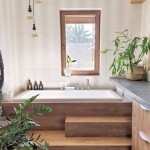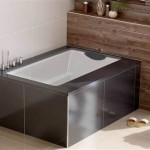Bathtub Tile Ideas For Small Bathrooms
Small bathrooms present unique design challenges, particularly when incorporating a bathtub. Space optimization is paramount, requiring careful consideration of every element, including tile selection. Tiles, beyond their aesthetic contribution, play a vital role in creating the illusion of spaciousness, enhancing light reflection, and improving the overall functionality of the bathing area.
Choosing the right tiles for a small bathroom bathtub surround can transform a cramped and uninviting space into a stylish and relaxing sanctuary. The following explores various tile options, design strategies, and practical considerations for maximizing the impact of tiles in a compact bathroom setting.
Utilizing Light and Size to Create Visual Spaciousness
One of the most effective strategies for making a small bathroom feel larger is to maximize light reflection. Lighter colored tiles, such as whites, creams, and soft pastels, are highly reflective and can significantly brighten the room. Glossy or polished finishes further enhance light reflection, creating a more open and airy atmosphere. Conversely, darker colors tend to absorb light, making the space feel smaller and more enclosed. While dark accents can be used strategically, they should be employed sparingly in a small bathroom.
Tile size also plays a crucial role in perceived spatial dimensions. Larger tiles can create the illusion of a larger space by minimizing grout lines, which break up the surface and can make the room feel more cluttered. Fewer grout lines result in a cleaner, more streamlined look, visually expanding the area. However, very large tiles might not be practical in extremely small bathrooms, as they can require more cuts and waste, potentially offsetting any visual benefits. A balance between tile size and the overall dimensions of the bathroom is essential for achieving the desired effect.
Rectangular tiles, when installed horizontally, can visually widen a narrow bathroom. Conversely, vertically installed rectangular tiles can make the ceiling appear higher, adding a sense of height and airiness to the room. The direction of tile installation is a subtle but powerful design element that can significantly impact the perceived proportions of the space.
Furthermore, minimizing grout line thickness and using a grout color that closely matches the tile color can further enhance the illusion of seamlessness and spaciousness. This creates a more unified surface, preventing the grout lines from visually fragmenting the area and making it feel smaller.
Exploring Tile Materials and Finishes
The choice of tile material and finish not only influences the aesthetic appeal of the bathroom but also its functionality and durability. Several materials are commonly used for bathtub surrounds, each with its own set of advantages and disadvantages.
Ceramic tiles are a popular choice due to their affordability, durability, and wide range of colors and styles. They are relatively easy to clean and maintain and are resistant to water damage, making them suitable for wet environments. Porcelain tiles are similar to ceramic tiles but are denser and less porous, making them even more resistant to water absorption and staining. Porcelain tiles are also more durable than ceramic tiles and can withstand higher levels of wear and tear, making them a good option for high-traffic areas.
Natural stone tiles, such as marble, granite, and slate, offer a luxurious and sophisticated look. They are highly durable and can add a touch of elegance to the bathroom. However, natural stone tiles are typically more expensive than ceramic or porcelain tiles and require more maintenance. They are also more porous and susceptible to staining, so they need to be sealed properly to prevent water damage.
Glass tiles are another option that can add a unique and modern touch to the bathroom. They are highly reflective and can brighten up the space, making it feel larger. Glass tiles are also non-porous, making them resistant to water damage and staining. However, they can be more expensive than ceramic or porcelain tiles and may require specialized installation techniques.
The finish of the tile also plays a significant role in its aesthetic appeal and functionality. Glossy or polished finishes are highly reflective and can enhance light reflection, making the room feel larger. However, they can also be slippery when wet, so they are not recommended for shower floors. Matte finishes provide a more subtle and understated look and are less slippery than glossy finishes, making them a good option for shower floors. Textured finishes can add visual interest and provide additional grip, making them a safe and practical choice for wet areas.
Strategic Tile Placement and Design Patterns
Beyond the choice of tile color, size, and material, strategic tile placement and design patterns can significantly impact the visual perception of the bathroom. Creating focal points and using patterns to draw the eye can add depth and interest to the space, making it feel more dynamic and less cramped.
A simple yet effective strategy is to create a feature wall behind the bathtub. This can be achieved by using a different tile color, material, or pattern on the wall behind the tub, drawing the eye and creating a focal point. This can be particularly effective in a small bathroom, as it helps to break up the monotony of the space and add visual interest.
Using a vertical stripe of accent tiles can also help to create the illusion of height. This can be achieved by installing a narrow band of contrasting tiles vertically along the wall, drawing the eye upwards and making the ceiling appear higher. This technique is particularly effective in bathrooms with low ceilings.
Another design strategy is to use a mosaic tile pattern to add visual interest. Mosaic tiles are small tiles arranged in a pattern, and they can be used to create intricate designs or simple geometric patterns. Mosaic tiles can be used as an accent on a wall or floor or as a border around the bathtub. They can add a touch of personality and style to the bathroom without overwhelming the space.
Extending the same tile from the bathtub surround up to the ceiling can create a sense of continuity and visual expansion. This helps to blur the boundaries of the space, making it feel larger and more open. This technique is particularly effective when using light-colored tiles.
Another approach is to install a niche in the bathtub surround for storing toiletries. This not only provides convenient storage but also adds a visual element to the space. The niche can be tiled with the same tiles as the surround or with a contrasting tile to create a focal point.
Finally, consider using decorative tile trim to add a finishing touch to the bathtub surround. Tile trim can be used to create a clean and polished look and can also help to protect the edges of the tiles from chipping or damage. Tile trim is available in a variety of materials and styles, so it is possible to find a trim that complements the overall design of the bathroom.
Throughout the tile selection and installation process, it is crucial to consider several practical factors. Proper waterproofing is essential to prevent water damage and mold growth. A professional installer can ensure that the tiles are properly installed and sealed to create a watertight barrier. Ventilation is also important to prevent moisture buildup and maintain air quality. An exhaust fan should be installed in the bathroom to remove excess moisture after showering or bathing.

Small Bathroom Shower Tile Ideas 2025

Bathroom Tile Ideas For Small Bathrooms Arizona

21 Stunning Shower Tile Ideas For Small Bathrooms

70 Gorgeous Bathroom Tile Ideas For 2025

Small Bathroom Shower Tile Ideas 2025

Small Bathroom Ideas Make Your Feel Bigger Porcelanosa

16 Walk In Shower Ideas For Small Bathrooms To Make Them Look Bigger 34 St John Ltd

Tile Ideas For Small Bathrooms Stonesuper

20 Popular Bathroom Tile Ideas Wall And Floor Tiles

12 Fresh Bathroom Tile Ideas For 2025 Transform Your Space
Related Posts







